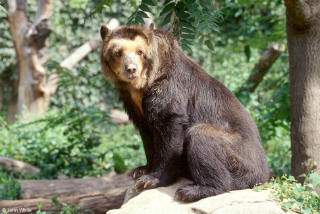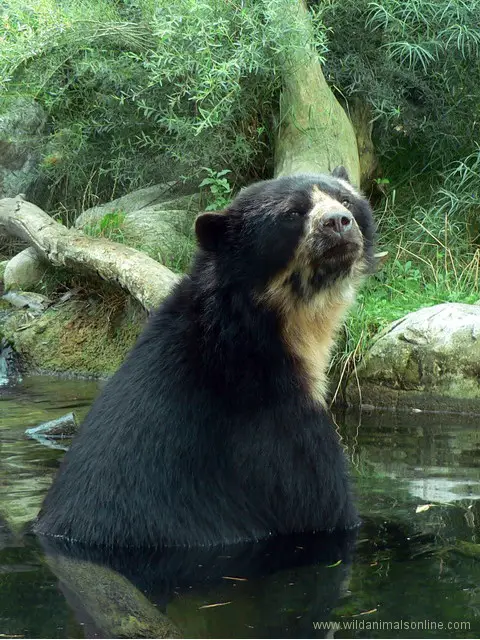Also known as the Andean Bear or Tremarctos Ornatus, the Spectacled Bear is the only bear species native to South America. Its name “spectacled” is derived from the distinctive pale or white markings that encircle its eyes, resembling a pair of spectacles. These unique facial markings make it instantly recognizable and give it an air of mystery and intrigue.
 Whenever a bear is spotted in South America, the viewer knows that it’s a Spectacled Bear. The bear’s face is marked with white around its eyes that give it a spectacled look. And if the viewer never sees the bear’s face to identify it? Since it’s the only species living in South America, they’ll still know that it’s the Spectacled Bear. It would be rare to see one of the furry creatures. Researchers estimate that there are only 18,000 living Spectacled Bears.
Whenever a bear is spotted in South America, the viewer knows that it’s a Spectacled Bear. The bear’s face is marked with white around its eyes that give it a spectacled look. And if the viewer never sees the bear’s face to identify it? Since it’s the only species living in South America, they’ll still know that it’s the Spectacled Bear. It would be rare to see one of the furry creatures. Researchers estimate that there are only 18,000 living Spectacled Bears.
The Spectacled Bear is most often found in the deep forests of Venezuela, Columbia, Ecuador, Peru, and Brazil, but may also inhabit other areas including rainforests, steppe lands, and deserts. They may also live in cloud forests or high altitudes. Wherever they live, there will be fruit available for feeding.
Spectacled Bears may be any color ranging from black to brown or a reddish tint. The adult bear is estimated to be 150 to 180 cm and weighs 100 to 155 kg. The male is often larger and heavier than the female bear. Standing on all fours he’ll stand about 76 cm tall at the shoulder.
Variety is the spice of life when it involves the Spectacled Bear’s diet. It will eat anything from vegetation, small animals including mice, rabbits and birds, orchid bulbs, leaves, and fruit. Fruit is by far its favorite food. When the bear discovers a good supply, he’ll “set up camp” and hang out for several days to feast on the tasty treats.

When the female reaches four to seven years she’ll be ready to mate and bear cubs. The mating season occurs in April, May and June. After spending several weeks with her male counterpart she’ll deliver two (sometimes three) cubs somewhere between November and February. These furry little bears will weigh only 10 or 11 ounces at birth.
Unlike most bears, the Spectacled Bear is nocturnal. He will eat and do his traveling at night. When dawn arrives he will climb a tree to a “nest” or platform that he has constructed for sleeping in. Many bears climb trees, but most prefer to sleep in caves, overturned trees, and dens.
Unique Characteristics of the Spectacled Bear
Table of Contents
One of the most intriguing aspects of the Spectacled Bear is its physical appearance. They are relatively small in size compared to other bear species, with males weighing between 220-340 pounds and females typically weighing around 150-200 pounds. Despite their smaller stature, these bears are incredibly strong and agile, capable of climbing trees with ease thanks to their long, sharp claws.
What truly sets the Spectacled Bear apart is its unique coloring. Their fur can range from jet black to various shades of brown, with light-colored markings that resemble spectacles adorning their faces. These distinctive markings not only give them their name but also give each bear an individual pattern, much like a human fingerprint.
In addition to their striking appearance, Spectacled Bears also possess a remarkable diet. They are primarily herbivorous, with a diet consisting mainly of fruits, leaves, and bromeliads. However, they are known to be opportunistic eaters and will also consume insects, small mammals, and even carrion if food is scarce.
Another fascinating characteristic of the Spectacled Bear is its solitary nature. Unlike other bear species, Spectacled Bears are known to be more independent, with males and females only coming together during the breeding season. This solitary behavior makes them elusive and difficult to study, adding to their mysterious allure.
Although Spectacled Bears face numerous threats, including habitat loss and poaching, efforts are being made to protect and conserve these magnificent creatures. Understanding their unique characteristics and raising awareness about their importance in the ecosystem is crucial for their survival.
Habitat
Native to South America, the Spectacled Bear can be found in several countries across the continent, including Peru, Bolivia, Ecuador, Colombia, and Venezuela.
These magnificent bears have a distinct habitat preference, primarily inhabiting the cloud forests, montane forests, and páramo ecosystems found in the Andes Mountains. Their adaptability allows them to thrive in varying altitudes, from lowland rainforests to high mountainous regions reaching up to 4,800 meters (15,700 feet) above sea level.
One of the key factors contributing to the Spectacled Bear’s distribution is the availability of suitable food sources. They are primarily herbivorous, with a diet consisting of various plant materials such as bromeliads, cacti, fruits, berries, and bamboo. In certain areas, they may also feed on insects, small mammals, and carrion.
The unique markings around their eyes, which resemble spectacles or eyeglasses, give these bears their distinct name. These markings vary in shape, size, and coloration, making each individual bear easily identifiable. They also have a stout build, with a stocky body and strong limbs, well-adapted for climbing trees and scaling steep mountain slopes.
Diet and Feeding habits
Spectacled Bears are primarily herbivorous, with more than 95% of their diet consisting of vegetation. They have a wide-ranging palate and are known to consume over 100 different species of plants, including fruits, leaves, cacti, bromeliads, and even certain types of palm trees. This diverse diet allows them to adapt to changing food availability throughout the year.
One of the most interesting aspects of their feeding habits is their ability to climb trees in search of food. Spectacled Bears are agile climbers and will ascend fruit-bearing trees to feast on a variety of fruits, such as figs, avocados, and palm nuts. Their strong forelimbs and sharp claws enable them to navigate tree branches with ease, making them one of the most arboreal bear species.
In addition to their herbivorous diet, Spectacled Bears are also known to consume small amounts of animal protein. They may opportunistically prey on insects, rodents, and even the occasional bird’s nest, further diversifying their food sources.
Conservation status and threats
Habitat loss is a significant factor contributing to the decline in Spectacled Bear populations. Rapid deforestation, driven by human activities such as agriculture, logging, and urban expansion, has resulted in the fragmentation and degradation of their natural habitats. As a result, these bears often find themselves confined to smaller and isolated pockets of land, making it challenging for them to find enough food and mates.
Illegal hunting also poses a significant threat to the survival of Spectacled Bears. Despite being protected by law in many countries, they are still hunted for their body parts, which are believed to have medicinal or magical properties in certain traditional practices. Additionally, conflicts between bears and humans occasionally arise when bears raid crops or livestock, leading to retaliatory killings.
Efforts are underway to conserve and protect the Spectacled Bear. Conservation organizations, local communities, and governments are working together to establish protected areas, promote sustainable land use practices, and raise awareness about the importance of preserving this unique species. By addressing the threats they face and implementing conservation initiatives, we can help ensure the long-term survival of the Spectacled Bear and preserve the rich biodiversity of South America.
Did you know?
- Researchers have trouble learning about the Spectacled Bear because of its remote homes and shyness.
- The fur of the Spectacled Bear is thinner than North American Bears due to the warm climate they live in.
- The Spanish name for the Spectacled Bear is Uumari, which means short-faced bear.
Further Information on the Spectacled Bear:
E-mail to add your Spectacled Bear-related website.
Conclusion
We hope you enjoyed learning about the fascinating spectacled bear, South America’s enigmatic icon. These secretive creatures have captured the hearts and curiosity of many, and we are thrilled to have shed some light on their mysterious ways. From their distinctive markings to their unique behaviors, the spectacled bear truly is a remarkable species. As you continue to explore the wonders of the animal kingdom, we encourage you to appreciate and protect these magnificent creatures and their fragile habitats. Stay tuned for more captivating wildlife insights on our blog.
